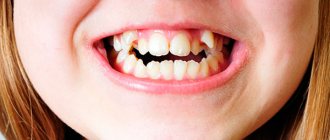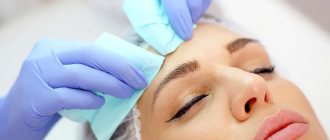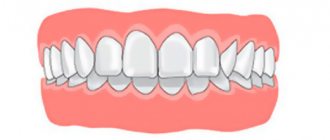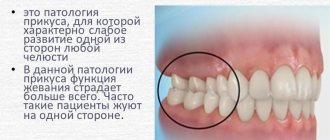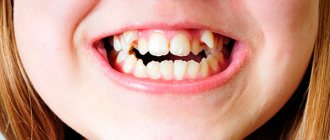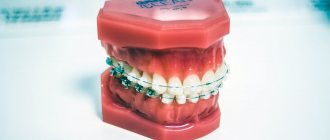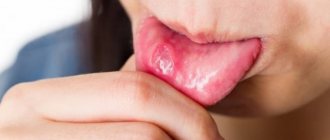Bite pathologies are one of the most common reasons for visiting a dentist. People have been engaged in returning teeth “to their place” since ancient times - there is evidence that this issue was of interest in ancient Egypt. However, only in recent decades have doctors come to the conclusion that it is necessary to correct an abnormal bite. Timely orthodontic treatment helps to avoid serious consequences for the entire body in the future. In this article, the leading orthodontist at the ZUUB dental clinic on Lipetskaya in Moscow, Dmitry Anatolyevich Polovkov, talks about the dangers of malocclusion and ways to correct it.
Correct bite - what is it?
Normal, or physiological occlusion, is characterized by the absence of disturbances in the arrangement of the dentition relative to each other with the jaws fully closed. He can be:
- regular, or orthognathic - in this case, the upper teeth overlap the lower teeth by a third of their height and there are no pronounced gaps between the dentition;
- straight - both jaws clearly close;
- biprognathic - both the upper and lower dentition are slightly tilted forward;
- progenic - only the lower jaw is pushed forward a little, but this does not prevent the cutting edges of the teeth from completely closing.
Correct bite is the absence of pronounced gaps between the teeth when the upper teeth are in contact with the lower ones opposite them. Orthodontists determine a bite without pathologies based on the following characteristics.
- The upper front teeth overlap the lower ones by 1/3 of their height.
- The incisors and canines are arranged in an even, arched line without distortions or crevices.
- The upper teeth protrude slightly outward, the lower teeth “look” slightly inward.
- All teeth are clearly below each other.
- The center of the jaws vertically coincides with the midline of the face, there are no protruding parts of the cheekbones or chin.
It is important to remember that in order to form a correct bite, you need to be careful about teething and caring for them.
Signs of correct bite
Determining the correct closure is quite simple and without professional knowledge. With a normal bite:
- facial features are proportional and harmonious;
- the upper jaw hangs slightly over the lower jaw, the upper incisors cover the lower ones by one third;
- the contact of molars and premolars is as dense as possible;
- the teeth are straight, without gaps;
- the upper canines are located symmetrically, each above the third and fourth lower teeth;
- the line of facial symmetry falls between the central incisors of both jaws.
Causes of malocclusion
Malocclusion (malocclusion) is due to various reasons: congenital or acquired. An important role is played by genetic factors, as well as insufficient intake of calcium into the mother’s body when carrying a child. Hereditary problems with bite require certain nuances in treatment. Therefore, before carrying out any orthodontic manipulations, the doctor talks with the parents and learns about all the possible factors in the occurrence of pathology.
Acquired malocclusion develops gradually. It appears at different ages due to its own reasons.
In childhood
- Bad habits (finger sucking, pacifiers, chewing on objects).
- Being on artificial feeding.
- Pathological bone formation.
- Teeth grinding (bruxism).
- Lack of sufficient solid food in the child's diet.
- Mouth breathing (formed as a habit or due to respiratory diseases).
- The replacement of baby teeth occurs too sooner or later.
- Pathologies associated with metabolism.
- Calcium and fluoride deficiency.
- Pronounced carious lesion.
- Injuries of the maxillofacial apparatus
In adults
- Installation of unsuitable dentures.
- Diastemas that form as a result of tooth extraction.
- Various types of injuries.
- Lack of space for eights (wisdom teeth).
- Unusual localization of the language.
- Diseases of the musculoskeletal system.
Causes of pathological bite
Factors that provoke improper closure of teeth can be divided into congenital and acquired.
Congenital malocclusion is caused by a genetic mutation, hereditary predisposition or pathology of intrauterine development of the fetus. Such anomalies are more difficult to correct and are often an indication for surgical intervention.
Acquired factors can manifest their effects both in infancy and in adulthood. Thus, the main reasons for the development of malocclusion starting from early childhood are:
- birth trauma of the skull;
- improper latching on the breast when feeding;
- long-term breastfeeding or bottle feeding;
- chronic diseases of the endocrine and respiratory systems;
- lack of essential microelements in the diet, unbalanced nutrition;
- previous rickets;
- bad habits – finger or foreign objects (pencil) in the mouth;
- early tooth extraction, jaw injuries.
With age, factors such as errors in prosthetics, gum disease, the absence of most teeth, and pathologies of the motor joint of the jaw are added.
Types of malocclusion in adults and children
Dentists usually divide anomalous occlusions into planes.
- Sagittal - characterized by elongated/shortened rows of teeth.
- Transversal - narrowed/expanded dentition is visible.
- Vertical - the presence of shortened/elongated certain areas in the dentition.
In addition, in dental practice it is customary to use the following classification of occlusion.
- Distal.
Sagittal occlusion with the upper jaw pushed forward. - Mesial.
Also a sagittal variety, but with the lower jaw moving forward. - Cross.
Transversal pathology with displacement of the jaws, which can only be partially formed, in one direction or another. - Open.
Vertical occlusion occurs with both partial and complete non-occlusion of teeth. - Deep.
The so-called traumatic, contributing to damage to the enamel. Characteristic is almost maximum overlap of the lower rows with the upper ones. - Vertical occlusal anomaly.
In addition to the above listed occlusion disorders, some experts identify 2 more types of anomalies:
- dystopic bite - displacement of one or more teeth;
- reducing - formed due to damaged and (or) lost teeth.
Modern methods of treatment
Bite correction can be carried out at any age, but the earlier treatment is started, the sooner and more effective the result will appear. Depending on the origin and type of pathology, as well as the age of the patient, malocclusion is corrected using the following methods:
1. For children:
- If the baby is under 7 years old, the doctor may recommend special massage and corrective gymnastics. This may be sufficient, provided that all the unfavorable factors described above are completely excluded;
- Trainers are special removable devices designed to guide teeth in the desired direction. This method provides a minimum of inconvenience, since it only needs to be used for a few hours a day. Most often used to correct bite in children under 12 years of age;
- removable plates - require long-term (1-2 years) use.
In childhood, treatment is quite easy and quick, since bone tissue has not yet completed its formation.
2. Malocclusion in adults is corrected mainly with the help of braces.
Of course, the decision on the need for treatment is made by the dentist, and then by the orthodontist. But parents should not lose vigilance and pay increased attention to the formation of their child’s jaws, and also try to avoid all factors predisposing to pathology.
How to correct a child's malocclusion
- Children under 7 years of age
are shown a set of gymnastic exercises and massage that will help solve the problem. - Children under 10 years of age
are already prescribed trainers, with the help of which they can set the desired direction for their teeth. They must be worn for a certain number of hours during the day. But, if the pathologies are more advanced, removable plates and mouthguards are used. Correction of the anomaly takes approximately 2 years. - For children aged 10-12
years, braces are used to correct their bite - special orthodontic structures consisting of a power arch and clasps that set an individual direction for each tooth. They cannot be placed at an earlier age; it is necessary that all milk teeth be replaced by permanent ones. How long to wear braces for malocclusion is determined by the treating orthodontist.
How to correct malocclusion in an adult
A very common treatment method for adults is wearing braces. Transparent aligners (aligners) are also very popular now. They are made of transparent plastic material. Aligners are effective in correcting impaired occlusion, are easy to use and look very aesthetically pleasing. All details about this technique can be found here.
In cases where the patient is not in the mood for long-term bite correction with aligners or braces, there is another solution - microprosthetics. In this case, special overlays are installed on the teeth - veneers, with the help of which you can correct uneven teeth and gaps between them. But if there are serious malocclusions, this technique is not used.
There are bite defects for which only surgical treatment is indicated. Examples include: severe malocclusion, facial asymmetry due to trauma or hereditary causes, and chin dysplasia.
Each method of orthodontic treatment has both indications and contraindications. Only an orthodontist can determine the method of treatment after a thorough examination and full diagnosis.
Consequences
If dental malocclusion is not corrected in a timely manner, irreversible consequences may occur, including:
- Dental pathologies.
- Diseases of the gastrointestinal tract.
- ENT pathologies.
- Speech disorders.
- Central nervous system disorders, headaches and joint pains, development of psychological problems.
- Violation of facial symmetry, aesthetic defects.
This is a short list of the dangers of malocclusion. Each item has a number of medical diagnoses of varying severity.
Therefore, if you suspect the formation of a pathological bite, you should consult an orthodontist as soon as possible, who will conduct a thorough diagnosis and give recommendations for further treatment.
Consequences of malocclusion
It is a mistake to think that a pathological bite concerns only appearance and only leads to an unattractive smile. This is where the problems arise that are more serious. For example, in 90% of people with abnormal occlusion, incorrect posture is also detected. There is a logical explanation for this: with a broken bite, the center of gravity of the head shifts. This in turn affects the compensation mechanisms of the musculo-ligamentous apparatus of the maxillofacial system. The result of all this is an increase in the pathology of teeth closure.
Aesthetically, occlusion abnormalities lead to facial asymmetry. A weak-willed chin becomes pronounced, and lips protrude unattractively.
Facial asymmetry due to crossbite
An abnormal bite contributes to the formation of facial asymmetry. It is also typical for the buccal form of crossbite with unilateral displacement of the lower jaw. The muscles on the right and left work with different tension - this also contributes to asymmetry. In this case, the chin moves to the side.
At an early age, this defect may not exist, but if the crossbite is not leveled in time, the asymmetry becomes more noticeable, and even after correcting the bite, it may not go away completely.
What is the danger of malocclusion?
In addition to visual problems, more serious dysfunctions often occur, including internal organs.
- Due to increased and uneven load on the teeth, periodontal disease develops and teeth begin to decay.
- Inadequate chewing of food leads to disruption of the digestive system.
- The functioning of the temporomandibular joint is impaired.
- The respiratory system also begins to malfunction.
- Slow metabolism.
- Increased risk of developing caries, especially with cross-closing teeth.
- Problems with pronunciation of sounds.
In addition, with malocclusions, daily dental care becomes much more difficult, which contributes to the constant accumulation of plaque on them.
Make an appointment
right now!
Polovkov Dmitry Anatolievich
Orthodontist
Malocclusions: consequences and complications
Unfortunately, if left untreated, malocclusion can become one of the factors provoking the development of a number of pathological processes in the body. In particular, malocclusion can be a consequence of:
- changes in the principles of functioning of the dental system;
- increasing the load on some teeth and weakening it on others;
- accelerated abrasion of the enamel layer of teeth;
- noticeable increase in tooth sensitivity;
- changes in the shape of the face, loss of its symmetry, appearance of aesthetic defects, disturbances in facial expressions;
- speech dysfunction;
- increasing the risk of injury to the tongue, cheeks, gums;
- increasing the risk of periodontal disease;
- TMJ damage;
- the appearance of inflammatory processes;
- problems arising during prosthetic and implantation procedures;
- the appearance of night apnea;
- respiratory dysfunction;
- the occurrence of diseases of the nasopharynx, digestive organs, and respiratory tract.
What to do to avoid malocclusion.
The consequences of malocclusion can be avoided by taking measures in time, namely in childhood. Here the responsibility falls largely on parents, who can promptly pay attention to problems and carry out prevention. It is important to take into account the risk of congenital disorders, hereditary predisposition, and also eliminate unfavorable factors:
- prevent the development of rickets and other diseases that impair bone growth;
- bottle feed your baby correctly;
- monitor the position of the child’s body during sleep (posture without tension, head not tilted back, etc.);
- maintain correct posture;
- timely wean your child off the pacifier, thumb sucking habit, toys and other objects;
- treat baby teeth immediately, because their early loss (as well as too late) can negatively affect the bite;
- to prevent nasal breathing disorders, namely to treat diseases of the ENT organs and ARVI.
When anomalies in the development of teeth are identified in childhood, timely assistance from an orthodontist will help solve problems faster than in advanced cases in adults. In children, as a rule, there is no need for surgical intervention yet, and even a complex of therapeutic exercises for the facial muscles can significantly help in correcting the bite.
Publisher: Expert magazine about dentistry Startsmile.ru
Stages of bite formation
Malocclusion manifests itself already in childhood, and its symptoms may include teeth moving forward or backward, gaps between teeth, rotation of teeth, etc.
In general, dentists identify five main stages of child development that affect the formation of the bite:
- 1. The period from the birth of the child to six months;
- 2. 6 months-3 years – formation of a temporary bite, during which the eruption of temporary teeth occurs;
- 3. 3-6 years – the period of formed temporary occlusion, when the jaws are actively growing and preparation for the eruption of permanent teeth begins;
- 4. 6-12 years – period of mixed dentition, eruption of permanent teeth;
- 5. 12-15 years – the period of formation of a permanent bite, during which milk teeth are replaced by permanent ones.
Virtual 3D setup from Star Smile - see your restored bite
A special feature of bite correction using Star Smile aligners is the ability to see the result of your treatment BEFORE it begins using a special computer program. See how this happens in case of crowded teeth:
The video shows how the 3D setup is done. In the Star Smile company, or more precisely in the clinics of its partners (which are more than 70 cities in Russia), any treatment
begins with diagnostics and drawing up a virtual setup. The doctor takes photographs of the patient’s face, dentition, as well as x-rays and dental casts. Using special software, the obtained data is processed and a three-dimensional model of the patient’s dental system is obtained. And this already allows you to calculate the trajectory of tooth movement, treatment time, and the required number of sets of aligners. Also, the final result of the treatment will be visualized - the patient will be able to evaluate the aesthetics of the smile after treatment. Patients really like this approach - they can see their future smile, their straight teeth. The 3D setup forecast for correcting malocclusion with aligners comes true in almost 100% of cases. You see, this is completely different from correcting a “blind” bite. Everything is clear here, without any guesswork or assumptions.
“Okay,” you say, “but in my case, can you help me?” — this is a question patients ask our orthodontists every day. See for yourself.
Mesial occlusion or progenia: what is it?
Several centuries ago, people with mesial occlusion were considered mentally retarded.
A similar defect was present in the composer Richard Wagner and Emperor Charles V, but such great people could not achieve great success with mental disabilities, so the theory was not confirmed. Since with a mesial bite the lower jaw is pushed forward, the face takes on a menacing and angry appearance. That is why pathology contributes to the formation of not only aesthetic, but also psychological problems: a person feels uncomfortable with such a defect. Problems of the dental system also develop. Incomplete closure of the teeth and the resulting gap between the jaws contribute to the accelerated proliferation of pathogenic microflora, which leads to various diseases of the oral cavity. Treatment of mesial occlusion is important not only for restoring facial aesthetics, but also for preventing various dental diseases.
Treatment in adults
Correcting jaw misalignment in adults is more complex and time consuming. First, the doctor installs braces. Devices are also installed according to indications. Either along with braces, or before putting them on.
Most often, braces are made of metal, ceramic, metal, sapphire and even plastic. Braces are glued to the teeth with medical glue. Then thin metal arches are brought to the bracket retainer, and the system is fixed in the correct position.
Getting used to braces is difficult. The process of addiction lasts from a couple of weeks to several months. You need to wear them from 12 to 36 months, and maybe more, according to medical indications.
After removing braces, grinding and polishing of the tooth enamel is required. Crossbite correction is quite effective and has minimal contraindications. If necessary, braces are not placed on all teeth, but only on those that need to be straightened. Braces systems are combined with the wearing of silicone crossbars on the front and side rows. Elastic bands are worn almost all the time, only when eating they need to be removed.
If conservative methods do not bring results, then the only method of correction is surgery. The surgeon opens the palate and widens the jaw using hardware systems such as a screw expander. When the expander is activated, pain occurs, but it passes quickly. The treatment is effective in about three to four months. It is secured with permanent metal retainers. This type of surgical intervention is recommended to be performed from 14 to 20 years, while the palatal suture has not yet completely ossified.
In case of severe jaw deformation, orthogenetic surgery is proposed, when the orthodontist changes the position of the jaws and fixes them. This is a complex operation, and not all patients agree to it. If the patient refuses such an operation, the doctor can only correct the bite as much as possible without changing the shape and position of the jaw bones. At the same time, the asymmetry of the cheekbones and chin, which is characteristic of a complex form of pathology, is also corrected.
Types of abnormal bite
With improper occlusion, sagittal deviations occur on the sides of the dentition. If the closure is disturbed in the anterior region (in the smile zone), they speak of a vertical deviation. The following types of malocclusion are distinguished.
Distal. Occurs if the size of the lower jaw is reduced. It looks “pushed” back, the upper jaw hangs over it. With such a violation, the position of the upper incisors may be different:
- deflected outward towards the lip. The profile becomes concave, the lips may not close completely, the lower lip is slightly pulled up and forward to compensate for this;
- deflected inward, toward the sky. With this anomaly, a deep fold appears on the chin, the lower lip seems too thick.
A distal bite is formed due to thumb sucking in childhood, improper swallowing, in which the muscles of the lips and cheeks become tense, and due to the habit of biting the upper or lower lip. It is often explained with gradual changes in diet: food becomes softer, chewing load decreases, and this affects the dental system. With such a violation of occlusion, diction worsens, biting, chewing hard foods is complicated, and pain may occur at the ends of the dentition and in the jaw joint.
Mesial. The reverse of the previous anomaly: the upper jaw is reduced. The cause may be birth trauma, genetic predisposition, early loss of teeth in the upper dentition. Mesial occlusion may be accompanied by crowding of the teeth in the upper jaw and a loose arrangement of the opposing teeth of the more massive lower jaw.
Mesial occlusion changes the face. Because of it, the profile becomes convex, the chin protrudes, the upper lip sinks, and the lower lip protrudes. With this pathology, the temporomandibular joint does not work properly, its ligaments are constantly stretched, and the masticatory and temporal muscles are overstrained. Because of this, headaches and discomfort when chewing and swallowing food are possible.
Open. With this anomaly, the incisors of the upper and lower jaws do not close. A horizontal gap may appear between them. With normal closure, the upper incisors overlap the upper third of the crowns of the lower incisors. If the bite is open, this overlap is reduced or absent. It can be front or side:
- anterior: when the lateral teeth are closed, there is no overlap of the incisors;
- lateral: when the incisors overlap each other, the molars and premolars do not close, leaving a gap between them.
The anomaly occurs under the influence of hereditary factors, due to improper formation of the bite in childhood (mouth breathing, improper swallowing, thumb sucking or long-term use of a pacifier, infantile type of swallowing). Such a violation of occlusion can occur due to endocrine diseases, tumors located on the face, jaw.
With an open bite, the mouth almost always remains slightly open; if the patient closes it, the face becomes tense. There are problems with biting food and swallowing it.
Deep. Occurs when there is excessive overlap of the lower teeth with the upper ones. It can be traumatic if the lower incisors rest against the palate when closing. The anomaly can develop in childhood (improper swallowing, using a pacifier for too long, thumb sucking, late teething in the lateral regions). In adulthood, the closure of the dentition is disrupted due to the early loss of molars (edentia, removal due to pulpitis, etc.). A deep bite changes the proportions of the face: its lower third is shortened, the lower lip turns outward, and the horizontal fold of the chin becomes more noticeable. With such a violation of occlusion, diction suffers: it seems that the person is talking through his teeth. There may be problems with biting, chewing food, and headaches.
Cross. When the jaws close, the teeth intersect. In this case, the teeth of the lower jaw can partially or completely overlap the upper dentition. An anomaly occurs if the dimensions of the jaws in the lateral region do not correspond to each other. This discrepancy may occur on only one or both sides. Subtypes of crossbite according to the type of displacement of the lower jaw:
- lingual: displacement towards the tongue;
- buccal: displacement towards the cheek;
- palatal: displacement towards the palate.
The disorder can occur due to birth trauma, during the formation of the bite (due to improper swallowing, long-term use of a pacifier, etc.), due to partial edentia, incorrect or untimely teething. With crossbite, the most complications arise: aesthetic defects, problems with diction, eating, gastrointestinal tract, gum condition, etc.
Do you have questions about malocclusions?
We will call you back within 30 seconds
+7
Ways to correct a bite
Today there are four ways to correct a bite and one way to carefully disguise the problem.
- Aligners
- Trainers
- Bracket systems
- Surgical intervention
We have listed these methods in order from easiest to most difficult. You must understand that each case is individual, and depending on this, the doctor will select the optimal bite correction system. You can hide an unaesthetic bite with the help of veneers - we will also talk about them.
Aligners
Removable aligners that are created from dental impressions. The most modern way to correct a bite, which is suitable for the treatment of simple disorders.
After drawing up a treatment plan, the patient receives 3–5 sets of aligners of varying stiffness. The mouth guard is designed to last for two weeks, and then it needs to be changed to the next one, and so on until the final result. The course of treatment lasts on average 4–8 weeks.
Aligners need to be worn 24 hours a day, and this may not be comfortable for everyone. They are not suitable for deep bites. The mouthguard is designed so that it is “one step” ahead of the current position of the teeth in the dentition. Therefore, after putting it on, pressure is felt, which is evenly distributed throughout the jaw. Aligners consist of an elastic transparent material, so they are invisible to others, unlike braces.
Trainers
Removable silicone mouth guards for two jaws, which help correct a simple bite or consolidate the result. You need to wear the trainer during sleep and during the day for up to 4 hours.
Veneers
The characteristics are similar to crowns, but they are installed only on the front surface of the tooth in the form of a thin plate on a special dental glue.
Veneers can be composite, ceramic or zirconium. The first two types last about 10 years. Products made of zirconium dioxide with external porcelain coating - up to 15 years.
Veneers eliminate defects that arise as a result of cracks or damage to the integrity of teeth. A visually straight dentition is formed.
For the patient, the result of orthodontic treatment is aesthetics, and for the doctor, it is functionality. If your teeth are just crooked and your bite is perfect, you can get veneers or crowns. In other cases, you cannot do without braces: veneers do not correct the position of the teeth, but only mask their external imperfections.
Bracket system
Braces are small clasps that are attached to the teeth with a special composite glue. A metal arch is placed in the grooves of the braces - the most important element of the braces system. The arch has the shape of a regular dentition. She pulls her teeth, setting them in the correct position. In order for the bracket system to successfully complete its work, it is important to periodically change the arches to more elastic ones.
The doctor fixes the arch on the braces with special rubber bands - ligatures. Depending on the task at hand and the required force that will act on each tooth and jaw as a whole, the orthodontist can choose metal or elastic ligatures. The latter have a clear advantage - when they are changed, you can get rid of the bacteria accumulated under them.
Increased salivation in the first days after installation is a good reaction of the body. The tongue contains sensory neurons that, when food appears in the mouth, send signals to the brain to turn it into a food bolus. When braces are put on your teeth, at first the brain perceives them as food. This is the body’s reflex that there is something in the mouth, which means it needs to be treated with saliva in order to then swallow it. After some time, the salivary glands will get used to it.
Does it hurt to wear braces?
The first days are unusual, but not painful. But if braces scratch your lips and cheeks, you shouldn’t tolerate it. “ Make an appointment with your orthodontist. Sharp elements can be corrected with special materials and filled with special wax
“, our expert advises.
The same applies to tooth sensitivity: sign up for a diagnosis. It is possible that areas of demineralization have appeared. Depending on what the teeth react to, further treatment will depend.
Types of braces
Braces are classified according to the following criteria:
- material (metal, plastic, ceramic and sapphire);
- technique (classical and self-ligating, without ligatures);
- Place of installation (on the outer surface of the teeth - vestibular, on the inner surface - lingual).
Metal braces
Despite the fact that these are the oldest braces systems, they are still popular, and not only because they are the cheapest. Their main advantage is the minimal friction force between the groove and the arc, the magnitude of which largely determines the duration of the entire treatment.
The only negative is that such braces are noticeable on the teeth. However, modern designs differ from their ancestors - they are smaller and more convenient.
Plastic braces
Second after metal ones in the price range. Since plastic itself is not strong enough, the design has metal grooves. Their disadvantage is that such braces are stained by coffee, tea and other coloring products. They are also more fragile than others. However, plastic braces come in a variety of colors and shapes and are therefore popular in pediatric orthodontics.
Ceramic braces
More expensive, but stronger than plastic ones. The color matches the color of the teeth, which makes them almost invisible. Their disadvantage is higher friction between the arch and the bracket slot, which can increase the duration of treatment.
Sapphire braces
Artificial sapphires are used to make them. They are transparent and shimmer beautifully in certain lighting. This design will appeal to those who are sensitive to aesthetics.
Combined braces
Consist of several materials. In the smile area it can be ceramics or sapphires, and in the chewing area it can be metal.
Lingual braces
They are attached to the inside of the teeth and are invisible to others. Their main disadvantage is their high cost. Also, at first they may interfere with diction, but after 2-3 weeks the language adapts and the problem goes away.
Forms of mesial occlusion
When diagnosing malocclusions, three main forms are distinguished: dentoalveolar, gnathic (skeletal), and mixed. The first includes progeny, characterized by incorrect position of the teeth. For therapy, you can use a brace system. The second type of abnormal bites is accompanied by a violation of the size of the jaw bones. This is a complex form that often requires surgery to treat. With a mesial occlusion of a mixed form, a combination of skeletal and dentoalveolar signs is observed - abnormal jaw sizes and incorrectly formed dentition.
